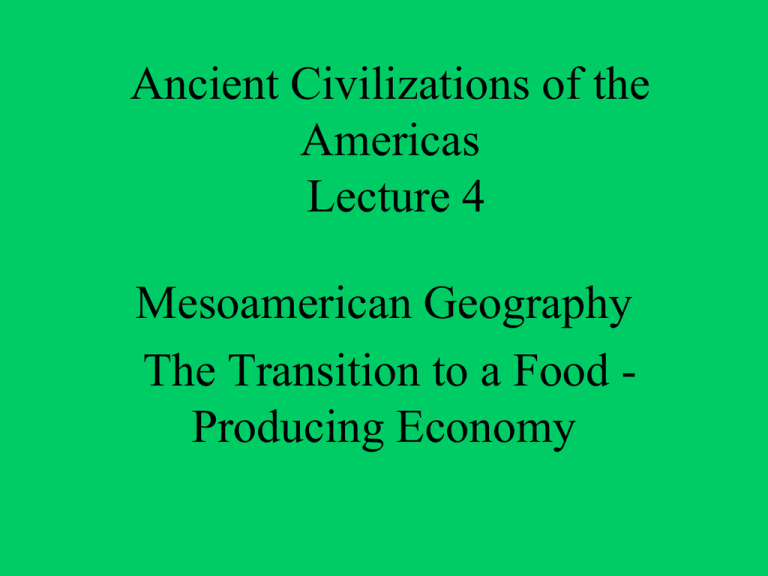Lecture 4 Mesoamerican Geography
advertisement

Ancient Civilizations of the Americas Lecture 4 Mesoamerican Geography The Transition to a Food Producing Economy 1. Mesoamerican Geography Yucatan Peninsula Palaloapan R. Gulf Coast Petén Balsas R. Mesa Central Isthmus of Tehuantepec Chiapas Mts. Soconusco 2. The Settlement of the Americas Significant early sites: Meadowcroft Rock Shelter, Pa 12,500 BC Santa Rosa Island, Ca • Arlington Springs Site, Santa Rosa Island, CA • Excavated by Phil C. Orr in in 1960 • Dates to 13,500 BC. • Points to the existence of watercraft, lending support to coastal migration theory. • Younger Dryas comet extinction occurred 12,900 years ago, impacting megafauna of North America. Fig. 1 Map showing the locations of CA-SRI-512 and Cardwell Bluffs sites relative to reconstructed Terminal Pleistocene paleogeography, including –60 m (dark tan) and –50 m (light tan) submarine contours that approximate paleoshorelines at ~12,500 and 11,000 cal BP. J M Erlandson et al. Science 2011;331:1181-1185 Published by AAAS Fig. 2 Paleocoastal artifacts from CA-SRI-512W. J M Erlandson et al. Science 2011;331:1181-1185 Published by AAAS Fig. 3 Chert projectile points from CA-SMI-678 and CA-SMI-679. J M Erlandson et al. Science 2011;331:1181-1185 Published by AAAS Deborah L. Friedkin Site, Buttermilk Creek, Central Texas Fig. 4 Buttermilk Creek Complex artifacts: (a) lanceolate point preform, (b) chopper/adze, (c) discoidal flake core, (d) radially broken flake with notch, (e) graver, (f) flake tool with retouch on a radially broken edge, (g and h) flake tools with marginal edge retouch, (i) polished hematite, (j) bifacially retouched flake, (k) radially/bend broken flake, (l) radially broken biface, (m and n) blade midsections, (o to s) bladelets. The Buttermilk Creek Complex dates to 15.5 thousand years ago based upon dates from optically stimulated luminescence. Published by AAAS M R Waters et al. Science 2011;331:1599-1603 • The site of Monte Verde is located along a creek flowing from a rainforest in northern Chile. It was discovered in 1976 by Tom Dillehay of the University of Kentucky. • Remains of the foundations of rectangular structures were found buried under peat. The inhabitants hunted mastodons and llamas. Spears and digging sticks were recovered. • Monte Verde dates 11,800 – 12,000 BC or 14, 800 years BP. • There may be an even older component to it a mastodon bone was found nearby dating to 33,000 years BP. • These early dates predate the existence of the Bering land bridge between Siberia and Alaska. 3. Paleo-Indians: Clovis 13,100 – 8,760 BC End of big-game hunting 7,000 BC. •“Overkill” hypothesis 4. Timetable of Domestication 32,000 BP Dog (Canus familiarus) 8,030-7,915 BC Bottle Gourd Genetic evidence indicates that it is derived from an Asian bottle gourd. 8,000 BC Squash (Curcubita pepo) 7,000 BC Pumpkins, Black Sapote, Chile Pepper, Avocado 5,000 BC Beans (Phaseolus vulgarus) family includes kidney, pinto, and navy 4,200 BC Maize (by accelerator 14C dates on corn cobs from Guilá Naquitz cave, Oaxaca, Mexico), and squash. Guilá Naquitz, Oaxaca • Excavated in 1966 by Kent V. Flannery. • Was a cave site in the eastern Valley of Oaxaca. • First full report published in 1986. • Updated report published in 2009 with new radiocarbon dates – Accelerator Mass Spectrometer dating was not available in ‘66. Radiocarbon dates range from c.8500 BC – 6000 BC AMS allowed for direct dating of plant specimens. (see dates above for gourd and maize. • Cave was visited short-term by foraging microbands. These harvested a variety of wild plants and animals from the local dry scrub forests: acorns, agave, mesquite pods, nopales, nanches, opuntia fruits, piñon nuts, beans, curcubit seeds, deer, peccary, raccoon, cottontail, hawk, owl, pigeon, dove, quail, etc. • Computer modeling suggested that domesticated plants were adopted to compensate for the variation in availability of wild species. • Initial domesticates were gourd and squash (Curcubita pepo) at 8,000 BC. • Excavation of Xihuatoxtla rock shelter in the Balsas River drainage of Guerrero produced maize phytoliths and starch grains dating to 7040-6660 BC. It took several thousand years for maize to be moved to Oaxaca. • The maize cobs from Guilá Naquitz could be determined to be domesticated as they had nondisarticulating rachis – could only be propogated by man. • Archaic cultivators were selecting for ears with four or more rows of kernels. Maize Wild Ancestry – teosinte (Zea mays ssp. parviglumis) Native to the Balsas River drainage of Guerrero and Michoacán Search for the earliest maize: The Tehuacán Archaeological Botanical Project – directed by Richard “Scotty” MacNeish 196065. Excavated San Marcos and Coxcatlán caves. In the Abejas phase (3400-2300 BC)wild foods made up 70% of the diet. Turkey • Domesticated c. 0 AD, initially for feathers and for ritual, in south-central Mexico. • 1100 AD bones turn up in middens, indicating a switch to food. 5. Sedentism Richard MacNeish found the earliest pit house in Tehuacán dated to 5000 BC Concentrations of pit houses were found dating to the Abejas phase (3400-2300 BC). These were held to be the residences of semi-sedentary macrobands. Alapan Phase (1500-900 BC) Permanent villages are established. Earliest evidence for Sedentism Lowland sites: Puerto Marquez, Guerrero – shell midden site with clay housefloors: 3000-2500 BC Palo Hueco, Veracruz: 3000 BC. (poss.) Basin of Mexico: volcano/island of Tlapacoya in Lake Chalco. Site of Zohapilco was a permanent village on the lake shore occupied between 5500 and 3500 BC. The population subsisted entirely from wild foods, like turtles and fish, supplemented by fruits and game from the surrounding forests.




